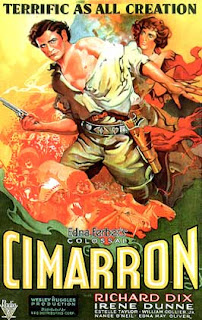So instead I end the first part of this journey with the final winning film- Cimarron a sprawling epic set during the 1880s and looking at the first settlers in Oklahoma as it became a boomtown and the life of a family experiencing it over fourty years. The film starts with erstwhile newspaper editor and lawyer Yancey Cravat returning home from the settlements after five years and taking his wife and son along with him to find a place to live in Oklahoma. Over time we see Yancey try and make the place more inhabitable by getting rid of all th
 e cowboys and bandits and setting up a new newspaper - The Oklahoma Wigwam as well as lessening the amount of taverns and undesirables in Oklahoma. Meanwhile Yancey's wife Sabra also becomes a valuable member of the community setting up a women's group and also looking after various facets of the newspaper and becomes a mother for the second time. As the film tracks later into the future Yancey starts to get restless and leaves home for large periods of time leaving Sabra to become the main face of the family. When Yancey comes back, Sabra starts to feel that he is tarnishing their reputation by writing reports about Native Americans having the same rights as them and defending a woman accused of being a prostitute. As the film gets int the early 1920s, Yancey has left again and Sabra is accepted into the U.S. senate and also acknowledges for the first time that her son has married a young American Indian girl. The final scene of the film sees her witnessing an old man being hit by a cart which turns out to be Yancey who then dies in her arms. Not a joyous ending but an interesting film nonetheless that deals with issues of restlessness, perception, race, class and gender.
e cowboys and bandits and setting up a new newspaper - The Oklahoma Wigwam as well as lessening the amount of taverns and undesirables in Oklahoma. Meanwhile Yancey's wife Sabra also becomes a valuable member of the community setting up a women's group and also looking after various facets of the newspaper and becomes a mother for the second time. As the film tracks later into the future Yancey starts to get restless and leaves home for large periods of time leaving Sabra to become the main face of the family. When Yancey comes back, Sabra starts to feel that he is tarnishing their reputation by writing reports about Native Americans having the same rights as them and defending a woman accused of being a prostitute. As the film gets int the early 1920s, Yancey has left again and Sabra is accepted into the U.S. senate and also acknowledges for the first time that her son has married a young American Indian girl. The final scene of the film sees her witnessing an old man being hit by a cart which turns out to be Yancey who then dies in her arms. Not a joyous ending but an interesting film nonetheless that deals with issues of restlessness, perception, race, class and gender.What is most notable about the film however, is the large number of extras involved in the early scenes as peole race to find settlements in Oklahoma. Indeed up to 5,000 extras were used in the film and up to 28 cameramen were employed at any one time. Indeed during the depression a film like this seemed to make a mockery of the state the country was in as RKO were able to lay on a budget of 1.5 million dollars. Another thing that is interesting in the film is the issue of race especially in the later scenes as the couple's son Cimarron, which incidentally means wild, marries the young Indian girl. While Yancey doesn't see a problem with equality others frown at the Indian settlers with Sabra describing them as 'dirty, filthy, savages' this issue is one of many in which views are challenged. The performances are pretty good Richard Dix plays the lead well a man who doesn't know whether to choose his family over new adventures and Irene Dunne is brilliant as his long-suffering wife, both were nominated for acting Oscars but neither were succesful. The film did win an award for its art direction which was more than justified and for its script which I did find long and meandering at times. I have only been able to watch two of Cimarron's competitors - The Front Page and Skippy both of which weren't half as good as this epic but unless I get to see the other two films I'll never know whether Cimarron deserved to win.
Right so 75 films watched and thats all I can do for the ceremonies between 1929 and 1939 for now. Next up are the ceremonies between 1940 and 1949 but before that a little look back at the decade I've just wrapped up.

No comments:
Post a Comment